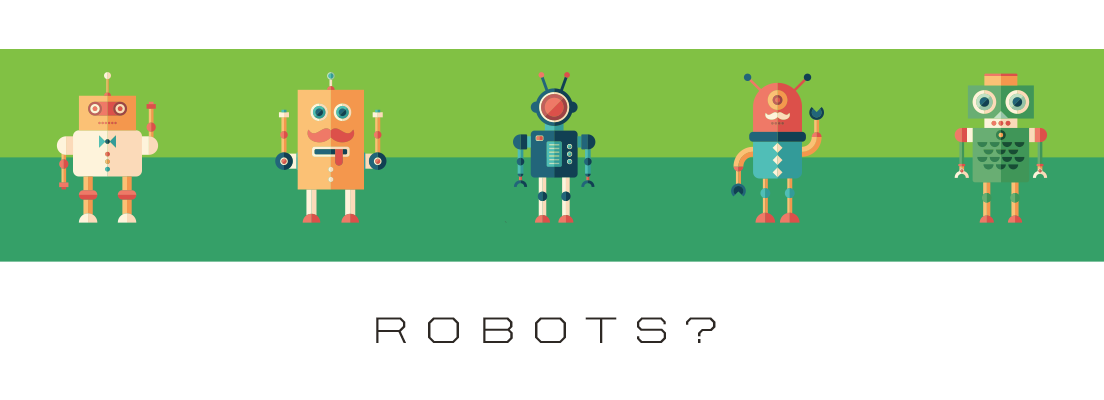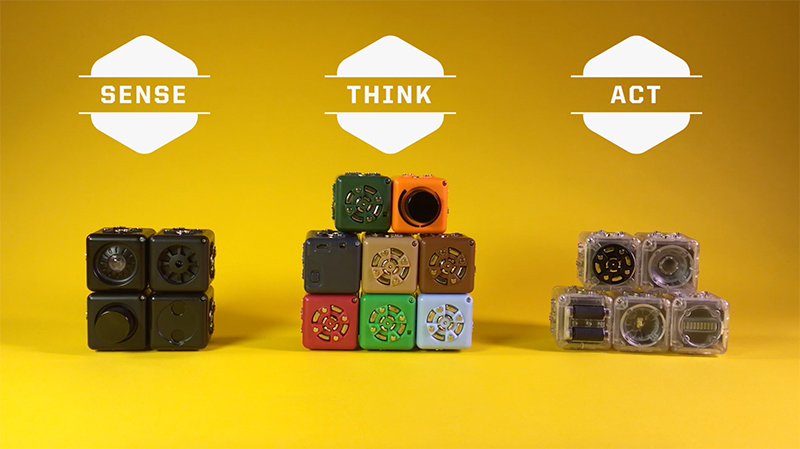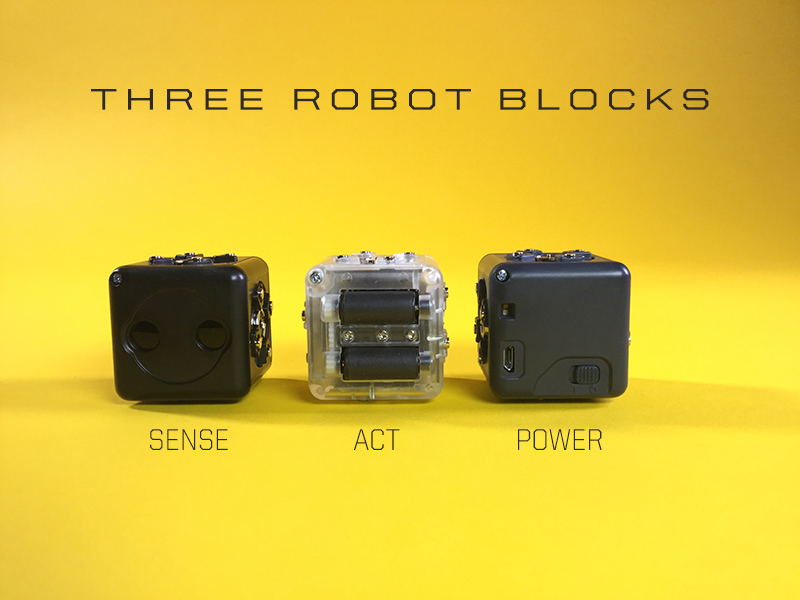A.K.2 | What is a Robot?
An Introduction to Robots and Cubelets
Created by: Brandy Ray
Lesson Overview:
In this early lesson students will begin to explore the differences between both robots and humans and robots and other machines. It is recommended that students have some opportunities to explore Cubelets before completing this lesson. See Lesson #1 in An Introduction to Robots and Cubelets for ideas on how to set up early explorations for Cubelets. We also recommend reading the Education Information Sheet for additional information regarding lesson plans.
The Basics:
Ages: 4-7Time: 2 sessions, Session 1: 25 min, Session 2: 15 – 20 min.
Lesson Objectives (for the students): Students will begin to articulate what a robot is using language such as: A robot is a machine that can think, sense, and act. Students will also construct a robot that senses and acts.
21st Century Skills: creative thinking, technology literacy
Concepts: Literacy, Science Technology, Math
Required Cubelets: Mini Makers or original Modular Robotics Educator Pack – all cubes for sorting activity; All sense, act cubes, and a Battery for each pair during the building activity.
Additional Materials: Recommended Book: Boy + Bot by Amy Dyckman
The Standards:
ISTE: International Society for Technology Education- ISTE Standard – Creativity and Innovation A: Apply existing knowledge to generate new ideas, products, or processes
- CCSS.MATH.CONTENT.K.MD.B.3: Classify objects into given categories; count the numbers of objects in each category and sort the categories by count
- CCSS.ELA-LITERACY.RL.K.1: With prompting and support, ask and answer questions about key details in a text.
- Pre-K TS GOLD Standard 13 – Cognitive: Uses classification skills
- Pre-K TS GOLD Standard 18 – Comprehends and Responds to Books and Other Texts: Interacts during read alouds and book conversations
- Pre-K TS GOLD Standard 24 – Science and Technology: Uses scientific inquiry skills
- K-LS1-1: Use observations to describe patterns of what plants and animals (including humans) need to survive.
Lesson Plan: Part 1
I. Pre-assess Student Ideas about Robots:
Time: 25 Minutes
Ask students to draw a picture of a robot. After they’ve drawn their picture, ask them to tell you what a robot is. If they are emergent writers, have them dictate their thoughts to you and then write down their response on their drawing.
II. Read Boy + Bot by Ame Dyckman:
Today we are going to read a story called Boy + Bot. While we read, I want you to pay attention to how Boy and Bot are similar, or alike, and how they are different.
Connect to Vocabulary: Preview the following words in the story or discuss them as they come up in the text.
- Affirmative – yes
- Malfunction – to stop working the right way
- Inventor – a scientist who makes new things
III. Discuss the Text:
Use the following discussion questions to help students examine the differences and similarities between robots and humans.
- Why did Boy think Bot was sick? Why did Bot think that Boy was sick?
- Why do the characters have different needs?
- How are robots and humans similar and different? Record student ideas.
IV. Robot or Not:
Explain to students that a robot is a special type of machine that can sense, think, and act. This means that robots can learn information from their environment, use a computer to think about the information, and then perform an action. In the story, Bot uses his sensors to see when he thinks Boy is “malfunctioning”, when he thinks about the information he gets when he sees Boy, he acts by taking Boy to the inventor. Luckily, the Inventor figures out that Boy is only sleeping!
Lesson Plan: Part 2
Explore how Cubelets Think, Sense, and Act:
Time: 15 – 25 Minutes *Note: Part 2 can be completed on the same day as Part 1 or the following day.
In part 2 of this lesson, students will begin to develop an understanding of the Sense, Think, and Act cubes. They will also build basic robots using only three cubes: a Sense cube, an Act cube, and the Battery (Think cube).
Materials: Getting Started Educator Pack – all cubes for Step II sorting activity, all Sense, Act cubes, and a Battery for each pair for Step III building activity.
I. Robots Sense, Think, and Act:
We learned that robots are machines that sense, think, and act. Today we are going to make a robot using as few robot cubes as possible. Make a prediction: How many cubes do you think it will take to make a robot that senses, thinks, and acts?
Tell students it takes at least three cubes to build a robot: a Sense cube, Think cube, and Act cube. Show students the Battery cube. “Every robot needs this think cube. It’s the Battery cube. When you flip the switch on the side, it tells all the robots to turn on.”
Let students know that in addition to the Battery cube, they will also need one black Sense cube. Look at the Sense cubes with the students and have them talk about what they notice and make predictions about what the cubes might sense. Model for students by picking up the Distance cube and saying, “I notice this cube has two small circles that look like eyes.”

After exploring the Sense cubes, show students the clear, Action cubes. Say, “Make a guess about what kind of action one of these cubes might do.” Show students a variety of Action cubes and talk about what action they think each cube might perform. Let students know that they need a clear, Action cube as well as a Sense cube, and the Battery cube to make a robot.
*A Note about Student Understanding: Students may not fully grasp the Sense, Think, and Act cubes in this lesson, but modeling this type of thinking and talking about the types of cubes with repetition can help build these connections. For a deeper student understanding of the sense cubes, see Lesson 3 in Our First Robotics Unit.
II: Sense, Think, Act Sort:
Sorting cubes will help students understand that there are three different types of cubes. It also presents great math connection opportunities. For this activity, you can have students sort all the cubes in the Mini Maker Educator pack with you, or you can select a variety of types of cubes to be sorted.
Connect to Math: CCSS.MATH.CONTENT.K.MD.B.3 Classify objects into given categories; count the numbers of objects in each category and sort the categories by count
Before building, ask students to help you sort the Cubelets into three categories: sense, think, and act. Remind students that some cubes sense, which means that the cube gets information from its environment like when we see or hear. Some cubes think or tell the other cubes what to do, and some cubes act, or do something.

Model thinking for students by picking up the drive cube and saying, “This cube has wheels, so I think it’s an act cube, because it does something – drive!
If students struggle to sort the cubes, model thinking strategies with phrases like the ones below:
- Distance Cube – “I think this is a sense cube, because it looks like it has eyes.”
- Flashlight Cube – “I think this one is an action cube, because it looks like it lights up, and it is clear like the cube with wheels!”
- Battery Cube – “What do you think about this one? It is the Battery cube. It tells the other cubes to turn on, so it must be a Think cube.”
After you have sorted the cubes, count the cubes in each category. Which category has more?
Use the button below to print paper copies of Cubelets that can be glued onto the sides of each basket to make a Sense, Think, and Act basket:
III: Build a Robot:
Today we’re going to try to make different robots that sense, think, and act. Work with a partner to build a robot using the Battery cube, a black, sense cube, and a clear, Action cube. Don’t forget, it takes at least one black Sense cube, one clear Action cube and a Think cube (Battery) to make a robot.

Important: For this activity, remind students that the Battery is the most important Think cube because it gives power to all the other cubes. Let students know that you are going to take away the other Think cubes and give each group a Battery to use as their Think cube.
Build Tip: ? Since students get excited when they first start building with Cubelets and often just want to put as many cubes together as possible, keeping the cubes sorted into sense, think, and act baskets during this experience may encourage students to pay more attention to which types of cubes they are using to build their robots. Consider using different colored baskets for different types of cubes or labeling clear baskets with Cubelets pictures (see photograph).
You can also tell student groups that they can only have one cube from each basket at a time and that if they want a new cube, they have to trade their cube into the right basket. This may be a helpful way to make sure they only have one of each cube type.
IV. Share your Learning
After students have had some time to try different combinations. Ask them to share a robot they built. Use the following questions to encourage discussion
- How does your robot work?
- What action does your robot do?
- What would you call your robot based on its action?
- What do you think your robot senses?
Assessment:
Have students share one robot that they were able to make during the lesson. Ask them to point out the Sense Cube(s) and Action Cube(s) as well as the Battery Cube, to assess whether or not they were able to successfully use the three cubes needed to make a robot.
Classroom Management Tips:
- Cubelets are a Team: Remind students of the following expectations for working with Cubelets:
- Work Together – Sharing and taking turns helps us work as a team.
- Respect Materials – Teammates and scientists take care of their equipment. Use Cubelets with safe, gentle hands and always return them back to the place you found them.
- Talk it Out – Team members take turns sharing ideas about what will happen and what to do next!
- Split the Kit: Using multiple kits or splitting up a larger kit can help students access more materials which can decrease sharing issues. Remember that if you split up a larger kit, every group will need a Battery Cubelet. If using more than one kit, it can be helpful to number the kit and the cubes or print out a list of cubes that go with each kit, so kits remain separated.
- Charge It: Remember to charge the batteries for your cubes before and after each experience. If you have extra batteries it’s helpful to have these charging, so there are backups.
Reading your Cubelets: Every Cubelet has a small LED light in one corner which flashes (except for the Battery which stays solid). When the Cubelet is part of a robot and the robot’s Battery block is turned on, the LED light is on too. This LED light shows that the Cubelet is getting power and talking to its neighbors. Each Cubelet robot must have one Battery block, which powers all the other blocks in the robot.
The Battery block has a small switch. When you slide it to the O, the Battery block is off. Slide to the line and it is on. Turn it off to save battery life when you aren’t playing with your Cubelets.
The Battery block has an internal, rechargeable, battery. To recharge the Battery block, plug it into a micro-USB power source.
If you’d like a more indepth look into how Cubelets work, visit the Cubelets Getting Started Guide.
- Call for Backup: If group management becomes challenging in your setting, consider asking a parent volunteer or older student to come in and assist with activities. Young students are initially very excited and eager to build, so there will likely be lots of enthusiasm. If student enthusiasm makes it difficult for them to share or use the materials appropriately, consider going back to lesson one, Cubelets are a Team, so students can have additional opportunities to practice using and sharing the Cubelets.
This work is licensed under a Creative Commons Attribution-ShareAlike 4.0 International License.


